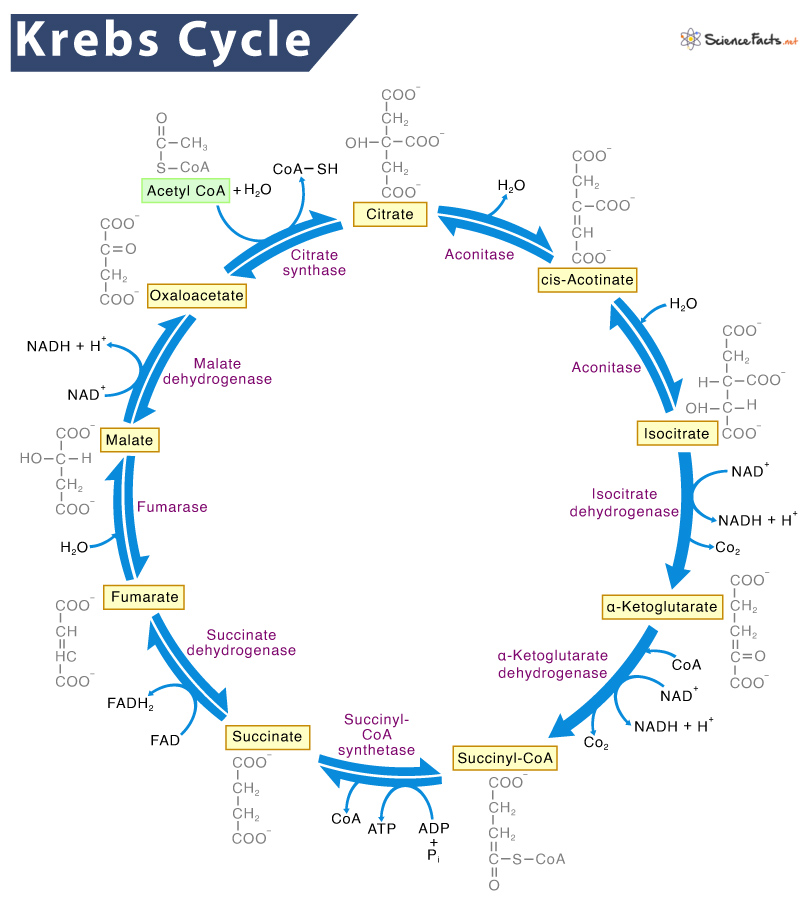Prior to the Krebs cycle, pyruvic acid (the product of glycolysis), which has three carbon atoms, is split apart and combined with coenzyme A, forming a two-carbon molecule acetyl-CoA. It then uses acetyl CoA, performs a series of redox reactions, and stores the energy in reduced electron carriers NADH, FADH2, and ATP. The electron carriers then pass their electrons into the electron transport chain and, through oxidative phosphorylation, generate most of the ATP in cellular respiration.
What is the Main Function of the Krebs Cycle
Where does the Krebs Cycle Take Place
What Happens During the Krebs Cycle
Krebs Cycle Mnemonic
What is the Main Function of the Krebs Cycle
Where does the Krebs Cycle Take Place
What Happens During the Krebs Cycle
Krebs Cycle Mnemonic
Its Steps
Step 1 – Citrate Synthesis: Here, the acetyl CoA condenses with the 4-carbon compound oxaloacetate to form a 6-carbon compound, citrate, releasing coenzyme A with the help of the enzyme citrate synthase. Step 2 – Isomerization of Citrate: Next, the citrate gets converted to its isomer, isocitrate. The enzyme aconitase catalyzes this reaction. Step 3 – Oxidative Decarboxylation of Isocitrate: Then, isocitrate undergoes dehydrogenation and decarboxylation to form 5C 𝝰-ketoglutarate. A molecular form of CO2 is released. Isocitrate dehydrogenase, the rate-limiting enzyme of the cycle, catalyzes the reaction. It is an NAD+-dependent enzyme. Here, NAD+ is converted to NADH. Step 4 – Oxidative Decarboxylation of Alpha-ketoglutarate: The 𝝰-ketoglutarate undergoes oxidative decarboxylation to form succinyl CoA, a 4C compound. The 𝝰-ketoglutarate dehydrogenase enzyme complex catalyzes the reaction. One molecule of CO2 is released, and NAD+ is converted to NADH. Step 5 – Cleavage of Succinyl Coenzyme A: In the next step, the succinyl CoA forms succinate. The enzyme succinyl CoA synthetase catalyzes the reaction. This step is coupled with substrate-level phosphorylation of GDP to get GTP. GTP transfers its phosphate to ADP, forming ATP. Step 6 – Oxidation of Succinate: The succinate thus formed is oxidized by the enzyme succinate dehydrogenase to fumarate. In the process, FAD is converted to FADH2. Step 7 – Hydration of Fumarate: In this step, the fumarate gets converted to malate by adding one H2O. The enzyme catalyzing this reaction is fumarase. Step 8 – Oxidation of Malate: Malate is dehydrogenated to form oxaloacetate, which combines with another molecule of acetyl CoA and starts the new cycle. Hydrogens which are removed get transferred to NAD+, forming NADH. Malate dehydrogenase catalyzes the reaction.
Equation
2 Acetyl CoA + 6NAD++ 2FAD + 2ADP + 2Pi → 4CO2 + 6NADH + 6H+ + 2FADH2 + 2ATP Reactant:
Acetyl CoA
Intermediates:
CitrateIsocitrateOxoglutarateSuccinyl-CoASuccinateFumarateMalateOxaloacetate (the end product)
What are the Products of the Cycle: Thus one turn of the cycle produces:
CO23 NADHFADH2GTP
1. Citrate Is Krebs Starting Substrate For Making Oxaloacetate. 2. Our City Is Kept Safe and Sound From Malice. C: Citrate I: Isocitrate K: Ketoglutarate S: Succinyl-CoA S: Succinate F: Fumarate M: Malate O: Oxaloacetate Krebs cycle, named from its discoverer Hans Kreb is an important part of aerobic cellular respiration in eukaryotes. It is also called the citric acid cycle from the first molecule, citrate it forms during the reaction or tricarboxylic acid (TCA) acid cycle due to the presence of three carboxyl groups on its first two intermediates. Prior to the krebs cycle, pyruvic acid (the product of glycolysis), which has three carbon atoms, is split apart and combined with coenzyme A, forming a two-carbon molecule acetyl-CoA. It then uses acetyl CoA and performs a series of redox reactions and stores the energy in reduced electron carriers NADH, FADH2, and ATP. The electron carriers then pass their electrons into the electron transport chain and, through oxidative phosphorylation, generating most of the ATP in the cellular respiration.
Its Steps
Step 1 – Citrate Synthesis: Here, the acetyl CoA condenses with the 4-carbon compound oxaloacetate to form a 6-carbon compound, citrate, releasing coenzyme A with the help of the enzyme citrate synthase. Step 2 – Isomerization of Citrate: Next, the citrate gets converted to its isomer, isocitrate. The enzyme aconitase catalyzes this reaction. Step 3 – Oxidative Decarboxylation of Isocitrate: Then, isocitrate undergoes dehydrogenation and decarboxylation to form 5C 𝝰-ketoglutarate. A molecular form of CO2 is released. Isocitrate dehydrogenase, the rate limiting enzymeof the cycle catalyzes the reaction. It is an NAD+-dependent enzyme. Here, NAD+ is converted to NADH. Step 4 – Oxidative Decarboxylation of Alpha-ketoglutarate: The 𝝰-ketoglutarate undergoes oxidative decarboxylation to form succinyl CoA, a 4C compound. The reaction is catalyzed by the 𝝰-ketoglutarate dehydrogenase enzyme complex. One molecule of CO2 is released, and NAD+ is converted to NADH. Step 5 – Cleavage of Succinyl Coenzyme A: In the next step, the succinyl CoA forms succinate. The enzyme succinyl CoA synthetase catalyzes the reaction. This is coupled with substrate-level phosphorylation of GDP to get GTP. GTP transfers its phosphate to ADP, forming ATP. Step 6 – Oxidation of Succinate: The succinate thus formed is oxidized by the enzyme succinate dehydrogenase to fumarate. In the process, FAD is converted to FADH2. Step 7 – Hydration of Fumarate: In this step, the fumarate gets converted to malate by adding one H2O. The enzyme catalyzing this reaction is fumarase. Step 8 – Oxidation of Malate: Malate is dehydrogenated to form oxaloacetate, which combines with another molecule of acetyl CoA and starts the new cycle. Hydrogens which are removed, get transferred to NAD+ forming NADH. Malate dehydrogenase catalyzes the reaction.
Equation
2 Acetyl CoA + 6NAD++ 2FAD + 2ADP + 2Pi → 4CO2 + 6NADH + 6H+ + 2FADH2 + 2ATP Reactant
Acetyly CoA
Intermediates
CitrateIsocitrateOxoglutarateSuccinyl-CoASuccinateFumarateMalateOxaloacetate (the end product)
What are the Products of the Krebs Cycle Thus one turn of the cycle produces:
CO23 NADHFADH2GTP
- Citrate Is Krebs Starting Substrate For Making Oxaloacetate.
- Our City Is Kept Safe and Sound From Malice. C: Citrate I: Isocitrate K: Ketoglutarate S: Succinyl-CoA S: Succinate F: Fumarate M: Malate O: Oxaloacetate
